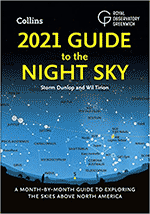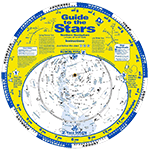|
2
|
Saturn at opposition (opposite the Sun) at 6h UT. The ringed planet is at its closest and brightest at mag. +0.2. Saturn's rings are spectacular even in a small telescope.
• Opposition (Wikipedia)
|
|
2
|
Moon at apogee (farthest from Earth) at 8h UT (distance 404,410 km; angular size 29.5').
|
|
2
|
Moon near the Pleiades (morning sky) at 11h UT.
• The Pleiades (Wikipedia)
|
|
3
|
Moon near Aldebaran at 5h UT (morning sky).
• Aldebaran (Wikipedia)
|
|
6
|
Moon near Castor at 15h UT (morning sky).
|
|
6
|
Moon near Pollux at 20h UT (morning sky).
|
|
8
|
New Moon at 13:50 UT. Start of lunation 1220.
|
|
9
|
Moon near Regulus at 16h UT (evening sky).
• Regulus (Wikipedia)
|
|
10
|
Moon near Mars (evening sky) at 4h UT. Mag. 1.8.
• Mars (Wikipedia)
|
|
11
|
Moon near Venus (evening sky) at 11h UT. Mag. −4.0.
• Venus (Wikipedia)
|
|
12
|
Perseid meteor shower peaks at 12h UT. Peak lasts about 12 hours. Active from July 17 to August 24. Produces swift, bright meteors (50-100 per hour) many with persistent trains. Best viewed after midnight.
• Perseids (Wikipedia)
• 2021 Meteor Shower Calendar (PDF) (IMO)
|
|
13
|
Moon near Spica at 15h UT (evening sky).
• Spica (Wikipedia)
|
|
15
|
First Quarter Moon at 15:20 UT.
|
|
16
|
Moon near Antares at 22h UT (evening sky).
• Antares (Wikipedia)
|
|
17
|
Moon at perigee (closest to Earth) at 9:20 UT (distance 369,124 km; angular size 32.4').
|
|
19
|
Mercury 0.08° S of Mars (16° from Sun, evening sky) at 4h UT. Mags. −0.5 and 1.8.
|
|
20
|
Jupiter at opposition at 0h UT. Best time to observe the largest planet in the solar system. Mag. −2.9.
• Opposition (Wikipedia)
|
|
21
|
Moon near Saturn (evening sky) at 0h UT. Mag. 0.3.
• Saturn (Wikipedia)
|
|
22
|
Moon near Jupiter (midnight sky) at 8h UT. Mag. −2.9.
• Jupiter (Wikipedia)
|
|
22
|
Full Moon at 12:01 UT.
|
|
29
|
Moon near the Pleiades (morning sky) at 19h UT.
|
|
30
|
Moon at apogee (farthest from Earth) at 2h UT (distance 404,100 km; angular size 29.6').
|
|
30
|
Last Quarter Moon at 7:14 UT.
|
|
30
|
Moon near Aldebaran at 13h UT (morning sky).
|
|
|
|
All times Universal Time (UT).
- US Eastern Daylight Time = UT − 4 hours.
- US Pacific Daylight Time = UT − 7 hours.
- Australian Eastern Standard Time = UT + 10 hours
- Singapore Standard Time = UT + 8 hours.
|



